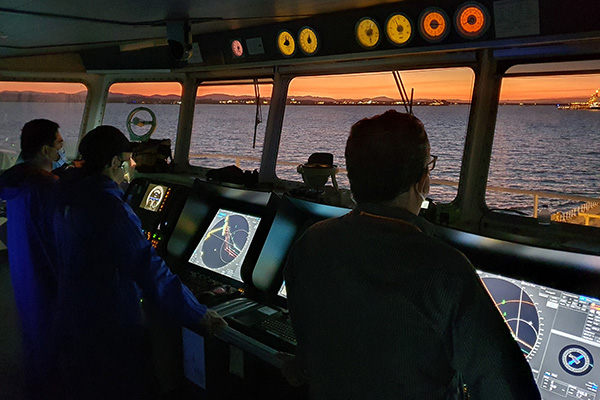A day in the life of a Mentor Pilot
Luke Sorensen began his career as a Marine Pilot in 2011. Now the Manager of Pilotage Services, North Queensland Bulk Ports (NQBP), he mentors Pilots moving through the NQBP Training Framework to become competent and confident in bringing ships into berth at our ports. Luke explains the process of mentoring.
"Pilot training has developed significantly since I became a pilot.
As an organisation, we recognised through our continual improvement process that we would like to create more opportunities for professional development with our Pilots. We now have a detailed Training Framework developed and executed by our pilotage team.
As a team, the pilots identified that there are some challenging pilotage movements that frequently occur that pilots benefit from sharing their learnings. We now provide mentoring to both new and existing Pilots to be aware of these situations and understand how to perform these safely to ensure they are competent to conduct them independently.
This mentoring program ensures that pilots learn from someone who has had the experience and can share their expertise and learning.
 Our program includes mentoring our most experienced Pilots to provide an opportunity to develop experience and skills and learn from each other continually. The training framework helps us identify complacency or old habits and helps us educate ourselves and our team on how to work towards an excellent outcome. The key to continual improvement for pilots is the want to learn more. This is what makes an exceptional Marine Pilot," said Luke.
Our program includes mentoring our most experienced Pilots to provide an opportunity to develop experience and skills and learn from each other continually. The training framework helps us identify complacency or old habits and helps us educate ourselves and our team on how to work towards an excellent outcome. The key to continual improvement for pilots is the want to learn more. This is what makes an exceptional Marine Pilot," said Luke.
Luke also explained that mentoring is required for each Pilot for each licence level at each Port.
"A Pilot licence is restricted by the length and beam of a vessel, and the initial round of mentoring and training is the most difficult.
This licencing requirement means that a Pilot can only control the size of vessel that they are licenced for according to size. To achieve each licence, the Pilot must complete a number of solo piloted ships; then, they advance to the next level for training.
This means that then they must complete our Observation/Mentoring and Check training program for each vessel size," said Luke.
The mentoring program is designed to ensure that the Pilot can complete complex pilotage manoeuvres during pilotage, including entering ports, transiting channels, coming alongside berth without the assistance of tugs pushing or using the weather or tide to assist.
The program also ensures all pilots are maintaining appropriate professional communication with the Port, tugs and crew to ensure every action is verbalised and understood with the teams providing support services onboard the vessel and within the bridge team, as well as support services of tugs, lines boats and shore side teams.
The verbalisation invites the bridge team into the single mental model of the Pilot's execution of the pilotage. The Captain, Officers, Tugs and Wharf is aware of the exchange, which allows the Captain to ensure their crew is aware and can make any supportive changes.
New Pilots are mentored continuously from the time of joining NQBP until their level 1 licence is achieved. The process is extensive, and it can take up to 18 months of full-time training for a Pilot just for one NQBP Port.
"A Pilot will be licensed for one Port initially, and this may be for a substantial period before beginning training at another Port. For example, we have two pilots who have been piloting ships at the Port of Hay Point for nearly seven years and have only just commenced their training for Mackay. This process will take them approximately two years to become fully licenced for Mackay," said Luke.
Learn more about pilotage at NQBP


